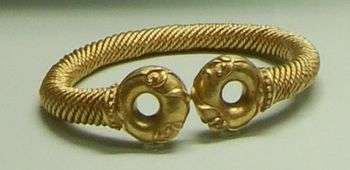Newark Torc
Coordinates: 53°04′51″N 0°50′04″W / 53.080827°N 0.834374°W
 | |
| Material | Gold |
|---|---|
| Created | 200BC-50BC |
| Period/culture | Iron Age, La Tène |
| Place | Newark-on-Trent |
| Present location | Millgate Museum, Newark |
The Newark Torc is a complete Iron Age gold alloy torc found by a metal detectorist on the outskirts of Newark-on-Trent, Nottinghamshire, England in February 2005.[1][2]
The torc is made from electrum, an alloy of gold, silver and copper,[3] weighs 700 grams (1.5 lbs)[1] and is 20 cm in diameter.[3] The body is formed from rolled gold alloy wires, which had then been plaited into eight thin ropes then twisted together. The terminals are ring-shaped and bear floral and point-work designs.[2][3] The torc was probably made in Norfolk.[3] It closely resembles the Great Torc from Snettisham, now displayed in the British Museum,[2] and is also closely similar to one found at Sedgeford, north Norfolk - so much so that one expert has suggested that they might have been made by the same craftsman.[4] The torc had been buried in a pit, and as such is considered a hoarded item rather than a stray loss. The reason for its deposition is uncertain, although Dr Jeremy Hill, head of research at the British Museum, speculated that it might have been buried "possibly as an offering to the gods."[4]
"[It is] probably the most significant find of Iron Age Celtic gold jewellery made in the last 50 years ... [it] shows an incredibly high level of technological skill in working the metal and a really high level of artistry. It is an extraordinary object." Dr Jeremy Hill.[4]
The torc has been dated to between 250 and 50 BC,[3] and is thought to have been buried in around 75 BC.[2] The torc was found by Maurice Richardson, a tree surgeon, while he was metal detecting in a field.
The torc was declared treasure trove in 2005 and purchased in 2006 for Newark's Millgate Museum, with significant grant aid from the National Heritage Memorial Fund.[3][5] The £350,000 proceeds were split between the finder and Trinity College, Cambridge, the landowner.[2] The torc was displayed to the press on 18 November 2008 at the British Museum.[2]
See also
| Wikimedia Commons has media related to Newark Torc. |
References
- 1 2 Martin Wainwright (2005-02-18). "Iron age necklace discovered". London: The Guardian. Retrieved 2009-11-30.
- 1 2 3 4 5 6 James Tozer (2008-11-19). "Pictured: The £350,000 Iron Age neckband discovered by one man and his metal detector". London: The Daily Mail. Retrieved 2009-11-30.
- 1 2 3 4 5 6 "The Newark Torc". The Art Fund. Retrieved 2009-11-30.
- 1 2 3 Stephen Adams (2008-11-19). "Metal detector man's £350,000 Iron Age neckband". London: The Daily Telegraph. Retrieved 2009-11-30.
- ↑ Sarah Dawes. "Council Meeting 17th June 2008 Agenda Item No 12: Exhibition of the Newark Torc" (PDF). Newark and Sherwood District Council. Retrieved 2009-11-30.
External links
- The Art Fund page on the Newark Torc
- "Iron Age necklace discovered" The Guardian
- "Pictured: The £350,000 Iron Age neckband discovered by one man and his metal detector" The Daily Mail
- "Metal detector man's £350,000 Iron Age neckband" The Daily Telegraph
- BBC webpage
- The Newark Torc on flickr